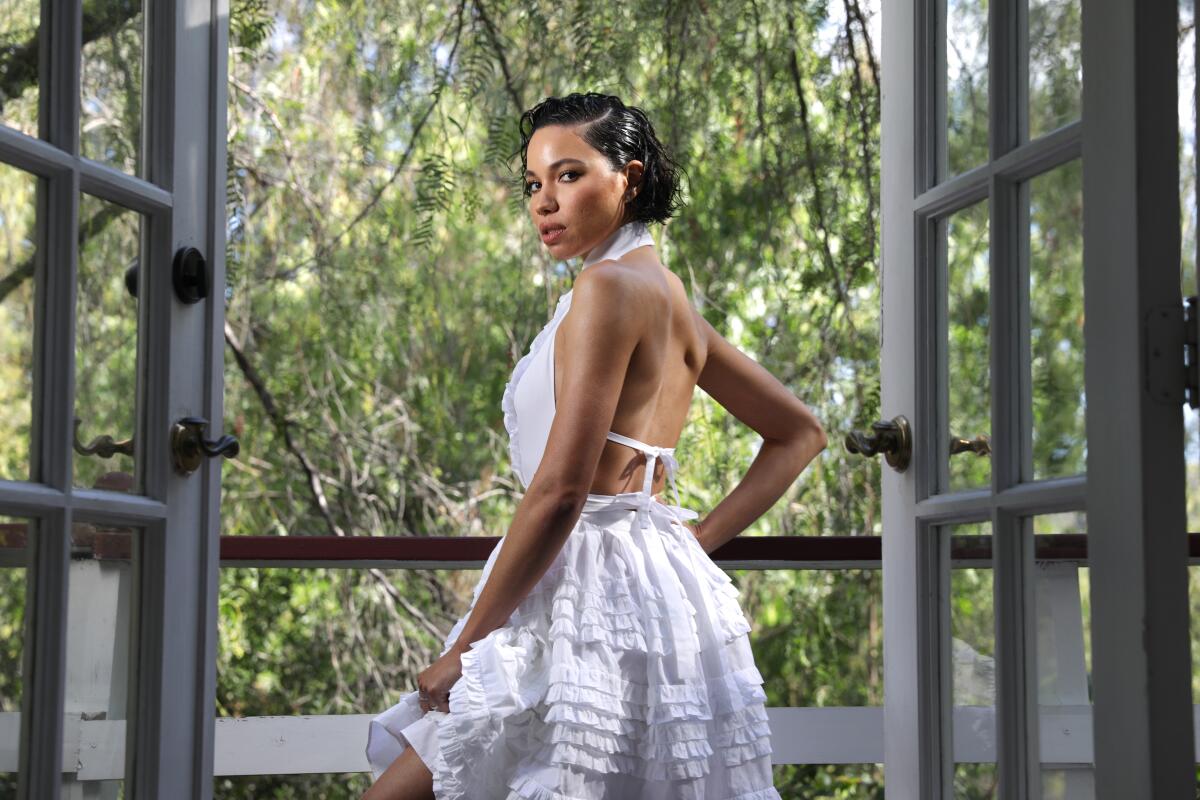Jurnee Smollett wears ‘Leti’s armor’ into ‘Lovecraft Country’

- Share via
One morning in Vancouver this summer, Jurnee Smollett sat in a hair and makeup trailer next to Allison Janney prepping for their new movie, “Lou.” Smollett’s phone rang. “I thought, ‘Oh crap, what bad news do you have?’” recalls Smollett, speaking from her rented home in British Columbia. “And it’s my publicist and she’s crying: ‘You just got nominated for best actress in a dramatic series!’ I started screaming.”
The nomination news served as a bittersweet aperitif to HBO’s announcement a couple of weeks earlier that “Lovecraft Country,” creator Misha Green’s 1950s-era sci-fi series featuring Smollett as anti-racist demon-fighter Letitia “Leti” Lewis, would not be coming back for a second season. “I was heartbroken,” Smollett says. “What actor wouldn’t be? Leti has been one of the great artistic experiences of my entire life. In telling this story about a woman who is a bit untamed, I did things I had never been asked to do before.”
And she’s done plenty. Smollett showcased her action chops as Black Canary in the superhero movie “Birds of Prey”; she demonstrated precocious emotional depth as the title character in the 1997 drama “Eve’s Bayou”; and starting at age 6, Smollett brought bubbly child actor charm to “Full House” and other sitcoms.
But “Lovecraft Country,” nominated for 18 Emmys, pushed Smollett well beyond her comfort zone, and not just because she visited the hospital three times during production to address stunt-related burns and stab wounds. For Smollett, the psychic wounds cut deeper. “When the Leti role came to me, there was so much chaos in my life, and part of it had to do with my inability to confront my own demons,” Smollett recalls. “I was hungering to use my voice in an unapologetic way.”
Emma Corrin, Hugh Grant, Ethan Hawke, Anthony Mackie, Elisabeth Moss and Jurnee Smollett take us behind the scenes to talk narcissists, grandparents and delivering meaningful work.
Early on in “Lovecraft Country,” a horror-filled road tests Leti’s screaming voice to the limit. She comes back from the dead feeling “like a ghost” but determined to make a new life for herself in Chicago. Smollett can relate. “I know what it’s like when you’re not seen, you’re not heard, when you’re not as unbound or as free as you’d like to be.”
In the pivotal “Holy Ghost” episode, Leti moves into a haunted mansion on Chicago’s white North Side. During a housewarming party, racist neighbors place a burning cross on her front lawn. Leti snaps, grabs a baseball bat, storms out of the house and smashes the windows of their cars. “I did not need that scene explained to me,” Smollett says.
“I just thought back to being a kid on the day of the Million Man March and seeing a dead fish on my family’s front lawn. This is in Los Angeles. I remembered seeing the N-word being keyed into our Suburban. I remembered my mother being called the N-word. Seeing it! Hearing it! To be Black and female is to know the rage Leti experiences in that moment: ‘How dare you violate my territory!’”
Before filming began in Illinois and Georgia, Smollett, a self-described “research junkie,” read works by Black writers from the period, including poet Gwendolyn Brooks, playwright Lorraine Hansberry and essayist James Baldwin. She also immersed herself in the concept of “blood memory.” Smollett explains, “It’s this visceral ancestral connection to your people, not just the oppression but also the triumph. Your blood knows. It vibrates.”
In “Lovecraft Country,” the so-called Ancestral Realm activates blood memory by connecting characters to the spirits of their forebears. When Leti, Atticus (Emmy-nominated costar Jonathan Majors) and Montrose (Emmy-nominated Michael Kenneth Williams) time-travel back to the 1921 Tulsa Race Riot, she receives a magical Book of Names from Atticus’ great-grandmother. The wrenching exchange, underscored by a recitation of Sonia Sanchez’s poem “Catch the Fire,” casts Black America’s resilience within a supernatural framework. Smollett says, “Our ancestors sacrificed so much for us, and now Leti’s going to carry the future forward.”
Smollett paid homage to her own grandmother by investing Leti with an immaculate sense of style. As many fans [on Facebook’s Lovecraft Country Discussion Group and elsewhere] have noted, Leti battles evil forces outfitted in sporty cropped pants, high-waisted shorts and pretty party dresses created by the show’s Emmy nominated costume designer, Dayna Pink. “We called it Leti’s armor,” Smollett says. “The way she dresses is not about vanity. It’s about dignity. There’s a big difference.”
Smollett elaborates. “My grandmother was a single mother in the ‘50sraising four Black children in the South. She used to be a beauty queen, brilliant and beautiful. Every day, she’d go to work cleaning the homes of white folks with her hair done and her dress pressed and her lipstick on. As soon as she stepped outside her home, the world was not a safe place, but my grandmother was not going to allow people to strip her of her dignity. She was not going to give them that power. That’s how we approached Leti’s costumes and makeup and hair. And that’s why we referred to it as Leti’s armor.”
More to Read
From the Oscars to the Emmys.
Get the Envelope newsletter for exclusive awards season coverage, behind-the-scenes stories from the Envelope podcast and columnist Glenn Whipp’s must-read analysis.
You may occasionally receive promotional content from the Los Angeles Times.








